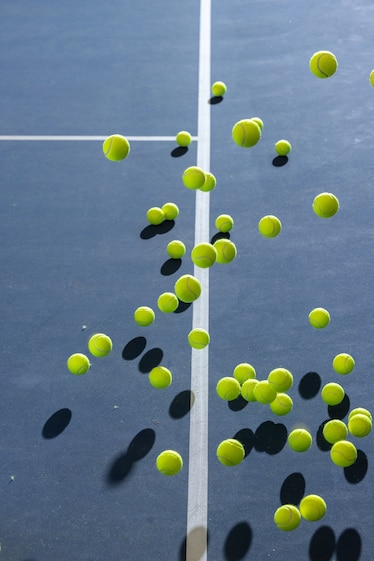The U.S. Open is now in full swing, and nearly 100,000 new tennis balls will be used. Unfortunately, that means thousands of tennis balls will soon be useless to the tournament’s top players.
After being whacked by racquets, balls quickly lose their signature bounce—which is why they’re regularly replaced at professional matches.
Producing and discarding those felt-covered, rubber-cored balls takes an environmental toll. Harvesting rubber contributes to deforestation, and nylon used for the exterior is typically made with petroleum. Every year, about 300 million tennis balls are produced but only a fraction is recycled or repurposed.
To reduce the impact of these fuzzy green balls, recycle them properly or give your old ones a second life.
Why tennis balls are so hard to reuse
If you’ve ever opened a fresh container of tennis balls, you know the satisfying release of air audible after the metal top is popped open like a soda can. That’s because tennis ball containers are pressurized.
When tennis balls are manufactured, they’re pumped with air so that more air pushes from the inside rather than the outside, making them bouncier. Sealed cans create an environment in which the air pressure in the can is equal to the pressure inside the balls.
Once the can has been opened, the outside air pressure drops, allowing the pressure inside the ball to slowly escape its rubber barrier and lose bounce.
And unlike footballs and soccer balls, which are also pressurized, tennis balls can’t easily be pumped back full of air. To keep playing with a ball at peak bounciness, you have to open a new container—and throw out the balls you’ve been serving, backhanding, and volleying.
For recreational tennis players, resealable pressure containers can help extend a ball’s life. But they won’t bring it back to its original bounce.
Send them to a recycling facility
Tennis organizations and environmental nonprofits are pioneering more sustainable alternatives to the landfill. At the U.S. Open, some of the balls will be collected and donated to tennis programs, and the nonprofit RecycleBalls will recycle a large portion of the balls used in matches.
“Tennis balls are notoriously difficult to recycle because you have both rubber and felt, and the adhesive attaching the rubber to the felt is really difficult to break,” says Erin Cunningham, the executive director of RecycleBalls.
Since 2009, the French Tennis Federation has been collecting used tennis balls and sending them to recycling facilities that remove their exterior and use the rubber for tennis courts.
In the U.S., RecycleBalls partners with gyms, athletic clubs, and players to collect used tennis balls and ship them to its recycling facility in Vermont where a bespoke recycling machine separates and processes the balls’ rubber and felt.
People in the U.S. with at least a hundred old tennis balls can ship them to RecycleBalls and receive a receipt for their tax-deductible donation.
And don’t forget the cans; they’re typically made of a type of plastic that can easily be recycled but often doesn’t make it to the blue bin.
Around the house
An old tennis ball may not be suitable for a pro, but if it’s still bouncy, it has other uses.
“Before we even start looking at recycling, we look at reuses first,” says Cunningham. “The more times you can use a tennis ball, the better it is for the environment.”
One common reuse is for the bottom of chairs or walkers. Slice an X into one side of a ball and slide it over each of the legs of a chair to prevent it from noisily moving over the floor, or do the same for a walker to help keep it stable.
Used tennis balls can also help with sore muscles. Throw one inside a sock or on the floor and lie or step on them to release muscle tension.
With a little creativity, an old tennis ball can take on multitudes: Toss them with the laundry to speed up drying time, use them as an alternative to packing peanuts, throw them in your pool to collect any oil residue on the water’s surface, or coat them in petroleum jelly and hang them nearby to ward off mosquitoes.
While you might be tempted to toss a used tennis ball to your dog, limit the time your dog spends chewing on it: A ball’s fuzzy covering can wear down tooth enamel.
And don’t be afraid to get creative. Tennis balls can make for unique material for art projects or collages.
“I like to think of tennis balls as having multiple adventures,” says Cunningham. “Its life doesn’t end on a tennis court.”
